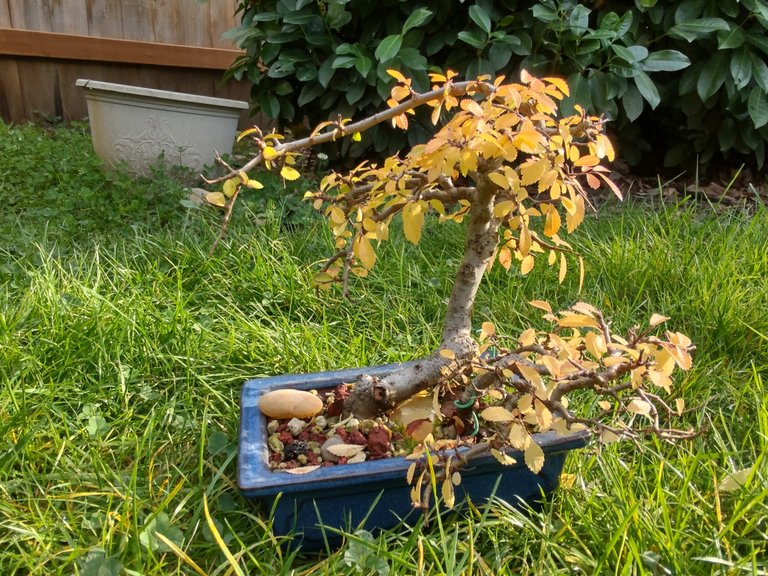
It's November, and the leaves of the Chinese Elm have turned into yellow gold paper.
In the afternoon light, it absorbs the filtered sunlight through the hazy sky. The air is cool and crisp, causing the tree to reabsorb the chlorophyll sugars into the roots, and causing the leaves to ripen and wither into paper thin petals.
The orangy, pinkish yellow leaves almost live up to the name of the tree, Peach.
Historical Info About This Tree:
ID: 0005
Nickname: Peach
Type: Chinese Elm
Age: 11
Grown: cutting
Last repotting: November 16, 2022
Wired: Summer 2023, top branch
Today is the day to check on the roots, and repot the tree. In past years, I know the Chinese Elm can grow a very thick taproot that will swirl around the base of the pot, which isn't ideal. We'll see that happens when I look into the soil medium.
Root Inspection
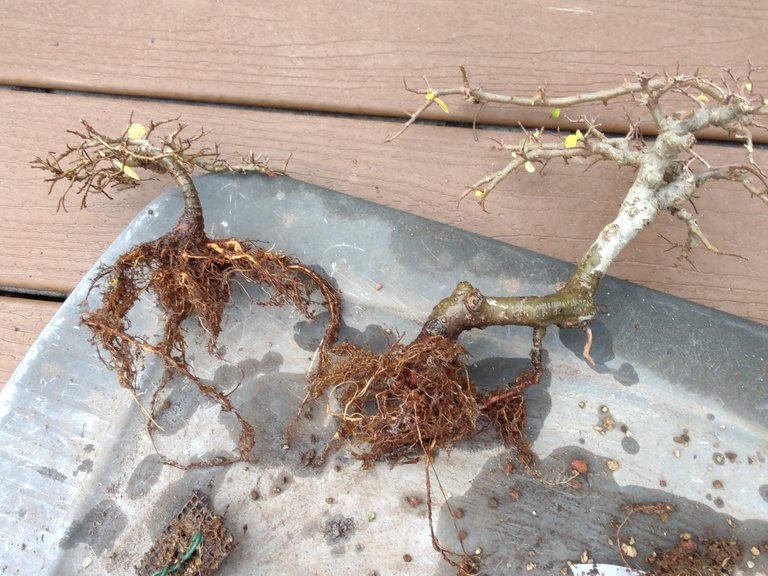
The soil was incredibly rocky and wet with slippery moss roots growing between. Furthermore the leaves were tumbling off almost immediately from handling the tree.
To really inspect the roots, I decided to completely separate all the roots from the soil, and even washed them loosely in a bucket of water.
Nothing exciting to see here. The roots are mostly growing thickly all in the same directions, and very thinly in a matted surface like a blanket on the base of the trunk root zone.
Root Clean-Up
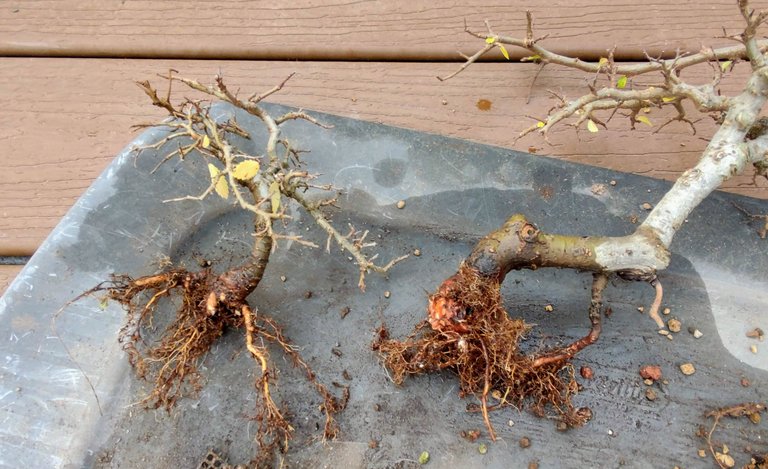
Some trimming was done to reduce the length and width of the roots to fit within the depth of the same pot. I prefer roots to be only barely touching the walls and base of the pot, rather than along them.
Any roots that were growing parallel from the same origin point were reduced to only one root per origin. In some cases I removed a thicker root to favor a straighter, narrower root as its root heir.
Lastly I clipped off any roots matting around the base of the trunk, or any roots growing directly on the underside of the trunk heading straight down, to prevent excess moisture retention which might cause rot to the trunk.
On the larger tree I even sliced the underside of the trunk in multiple places to see if it will induce healing or more root production. I don't know why, but this tree has continued to form a very bulbous base under the trunk, and tends only form roots from a couple spots.
Next year, I may need to consider growing this tree in a basket of a larger size to encourage the re-occuring taproots to airprune themselves, and force a thicker division of roots.
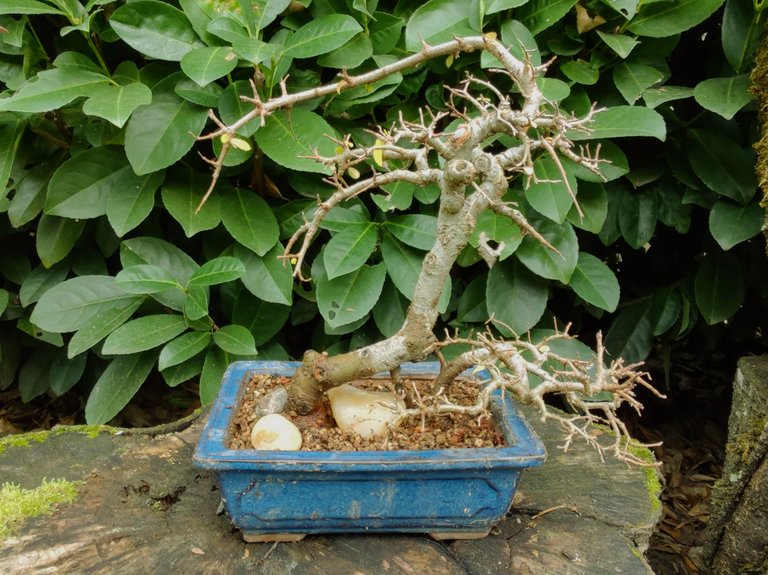
Here is the tree freshly repotted. It is very loose in the soil because I did not use an anchor wire. I did that on purpose, because it was so hard to get out of the pot with the anchor wire looped around the roots last time. So it will go into the greenhouse for a month or so to protect the roots from playful and hungry animals that like to dig, peck, and pull.
Next spring or summer, I will have the option to restyle the tree a bit.
Do you like the new arching top branch that was made last year from the new stems? Should it be reduced in length? Should any of the lower branches be removed? These are question I will need to consider.
It certainly has a weird pipework shape, and I would like to see less confusion in the overall design. Perhaps removing the branch that is splitting out from the trunk towards the back will bring more attention to the literati style heading towards the top arch.
Bonus
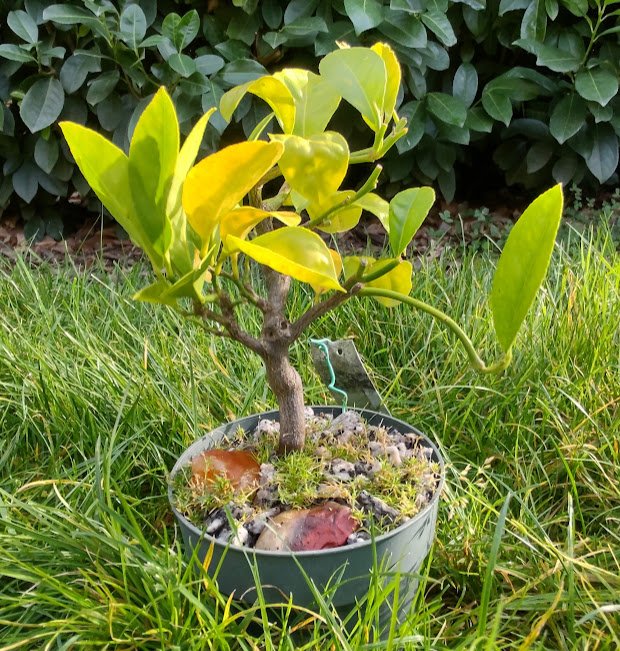
Here is a view of my lemon tree enjoying the change of the season. Some of the leaves are taking on the bright tones of golden yellow. It looks really healthy now as it adjusts to the colder season.
It had another attack of scale insects this past summer, but I kept a close eye on it, and scratched them off right after they appeared. No chemical treatments required. With my active diligence, there is no damage to any of the leaves or stems. Lemon tree leaves have a very thick cuticle, making them incredibly durable against biting insects and scratches.
Historical Info About This Tree:
ID: 0022
Nickname: Li'l Pucker
Type: Citrus Lemon
Age: 7 years
Grown: seed
Last repotting: November 2023 (and recently Nov. 3, 2024)
Last Wired: Never
In stark contrast, the pictured grass surrounding it is restoring itself with new healthy green shoots amongst the remaining old growth summer stalks which went dormant and turned wheat yellow.
Together, they represent opposites. One loving the hot summer heat, and the other loving the wet freezing air. Yet both producing the same green and yellow leaves at this time of year for either going into dormancy, or coming out of dormancy.
Don't worry, this tree is living inside the mini greenhouse this November, and soon will be moving indoors as soon as the first frost occurs.
Photos in this post are all #originalworks by @creativetruth, unless stated otherwise.


They all show promise! I do really like that overarching elm branch. I tried to think what could be removed but I like the overall "pipework" look, although to me it more closely resembles a haunted tree shape. The lack of leaves certainly add to this!
The looking lemon tree reminds me of all the ones I've lost, but luckily I still have their mother. Many were lost in bonsai experiments/practice. However, the better and more recent ones were killed due to my caretaker friend being careless while I was on vacation. Now I never want to go on any extended trips...
The worst part is when people say, "I don't know if it's dead or not..."
WHAT DO YOU MEAN‽
it's completely dead...
(The leaves looked like those of your Chinese Elm and the soil is bone dry and hardened into a single cake!)
That is interesting about your citrus trees. Were they grown from seeds or cuttings of the mother tree?
What I did for my citrus was to make sure the soil was so porous, it would be impossible to overwater.
The mother, which I'm now pretty certain is a limo (lima tree), was planted from seed. But all the ones I lost were just cuttings from it. They died from lack of water. My friend had neglected everything for a couple of weeks.
My neighbors let me have some cuttings from their tree, which is a lemon tree. But I've been procrastinating while they're just sitting in water. I had planned to try grafting at least some to my mother tree.
What does your soil mix consist of? Mine always tends to be too heavy. Do you use lots of perlite?
Coir and perlite or pumice, and a little activated charcoal to balance fertilizer and pH. A little bit of sphagnum moss near the bottom roots provides some extra protection from dry indoor air.
No compost or smelly organic fertilizers. The outdoor microbes will die indoors anyway, so you end up with a fly problem once it starts leeching compost juices.
Liquid fertilizer and slow release Osmocote pellets are best, in low doses, or none when the tree is transitioning or sick.
You can try lime again. I know mine died a few years ago because the soil was too much wet organic matter (peat). A hardy variety might survive better year after year. Persian Lime I think is what local nurseries sell for our climate.
Store bought cactus/citrus soil has worked well in my experience in larger scales. It's good, really available, and serves as a nice low maintenance soil for periods when it just needs to leaf out. Not that heavy. Generalist stuff.
I will apply your tips in my next generation of bonsai clones. Small amounts of the big bag soil really fluctuates unpredictably in terms of moisture content.
Yeah that sounds like it will work. Rooted cuttings probably need no fertilizer at all. Just keep it covered with a cup or humidity dome if you can. Same with a graft, keep it tightly wrapped in plastic.
Pure poetry ❤️ I love this passage. Great writing.
I find this shape very interesting how it comes back over the tree and appears to balance the tree. I always picture bonsai with a branch like this moving away for the trunk and center of the tree to make it appear impossibly unbalanced. But in this case I think I like it.